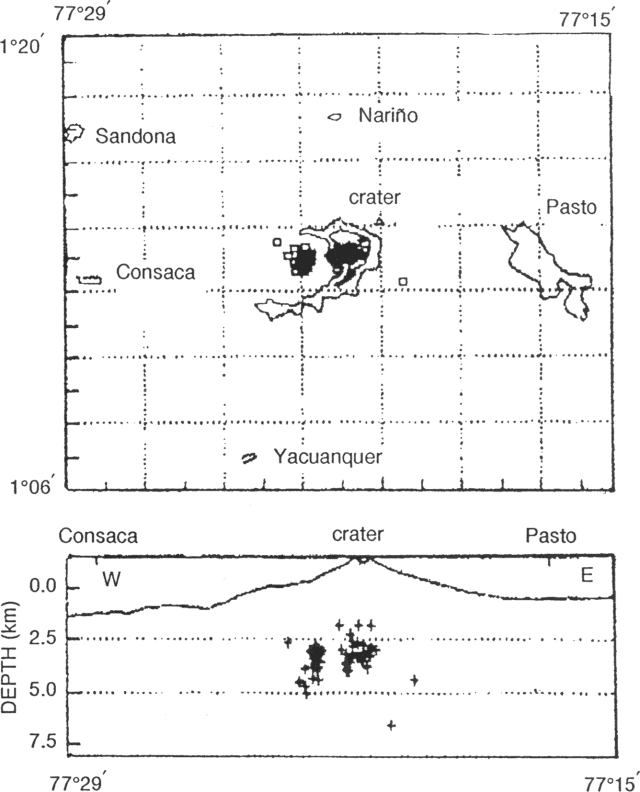Report on Galeras (Colombia) — November 1989
Scientific Event Alert Network Bulletin, vol. 14, no. 11 (November 1989)
Managing Editor: Lindsay McClelland.
Galeras (Colombia) Slight decrease in SO2 emissions; night glow; seismicity
Please cite this report as:
Global Volcanism Program, 1989. Report on Galeras (Colombia) (McClelland, L., ed.). Scientific Event Alert Network Bulletin, 14:11. Smithsonian Institution. https://doi.org/10.5479/si.GVP.SEAN198911-351080
Galeras
Colombia
1.22°N, 77.37°W; summit elev. 4276 m
All times are local (unless otherwise noted)
Overflights and fieldwork showed changes in the resurgent cone's activity during November. Linear zones of orange and light-yellow incandescence on the inner wall of the cone's W slope were observed on the night of 29 November, concentrated along radial and tangential fractures reported 10 September. A semicircular area of glow extended from the bottom of the crater to the top of the W wall. The sound produced by escaping gases had diminished ~30% since October. The Las Deformes fumaroles, ~50 m from the crater on the upper SSW flank (number 3 on figure 8), had increased in size and had deposited a thick crust of sulfur. Their measured temperature during the past 3 months ranged from 190 to 239°C.
SO2 flux measured by COSPEC had increased sharply in late October, exceeding 6,000 t/d during the last week in the month. Rates declined in November, remaining above 3,000 t/d until the 20th, then dropping below 1,700 t/d for the rest of the month.
Moderate seismicity was concentrated under the SW flank of the resurgent cone (2-4 km depths) and W of the cone (2.5-5 km depth) (figure 13), varying somewhat in number and magnitude. Tremor associated with surficial hydrothermal processes remained stable. There were no significant changes in the deformation measurements (EDM, dry tilt, and levelling vectors). Electronic tiltmeters continued to register variations that did not correlate with other parameters.
 |
Figure 13. Epicenter map (top) and E-W cross section (bottom) showing focal depths of 56 seismic events near Galeras, November 1989. No hypocenters are below 7.5 km. Courtesy of INGEOMINAS. |
Geological Summary. Galeras, a stratovolcano with a large breached caldera located immediately west of the city of Pasto, is one of Colombia's most frequently active volcanoes. The dominantly andesitic complex has been active for more than 1 million years, and two major caldera collapse eruptions took place during the late Pleistocene. Long-term extensive hydrothermal alteration has contributed to large-scale edifice collapse on at least three occasions, producing debris avalanches that swept to the west and left a large open caldera inside which the modern cone has been constructed. Major explosive eruptions since the mid-Holocene have produced widespread tephra deposits and pyroclastic flows that swept all but the southern flanks. A central cone slightly lower than the caldera rim has been the site of numerous small-to-moderate eruptions since the time of the Spanish conquistadors.
Information Contacts: INGEOMINAS, Pasto; INGEOMINAS, Manizales.

